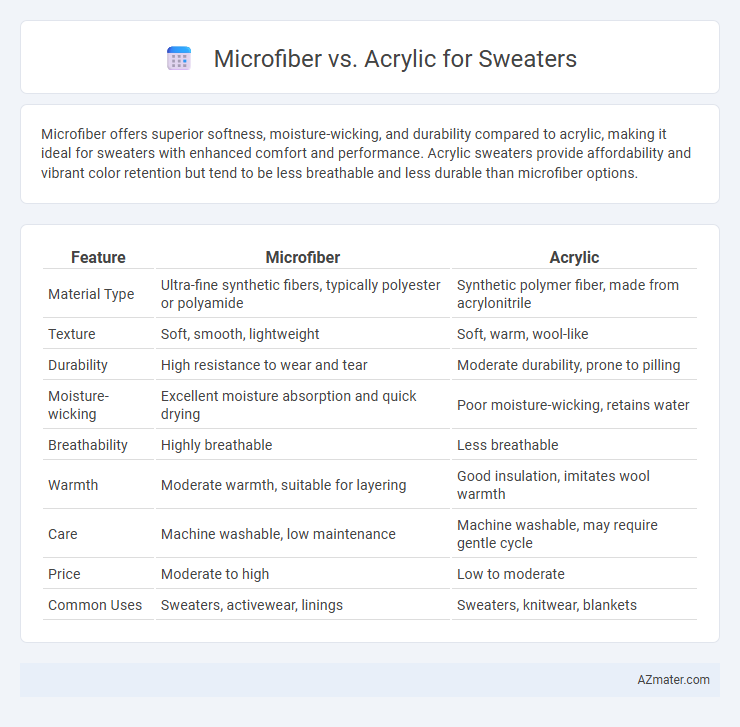Microfiber offers superior softness, moisture-wicking, and durability compared to acrylic, making it ideal for sweaters with enhanced comfort and performance. Acrylic sweaters provide affordability and vibrant color retention but tend to be less breathable and less durable than microfiber options.
Table of Comparison
| Feature | Microfiber | Acrylic |
|---|---|---|
| Material Type | Ultra-fine synthetic fibers, typically polyester or polyamide | Synthetic polymer fiber, made from acrylonitrile |
| Texture | Soft, smooth, lightweight | Soft, warm, wool-like |
| Durability | High resistance to wear and tear | Moderate durability, prone to pilling |
| Moisture-wicking | Excellent moisture absorption and quick drying | Poor moisture-wicking, retains water |
| Breathability | Highly breathable | Less breathable |
| Warmth | Moderate warmth, suitable for layering | Good insulation, imitates wool warmth |
| Care | Machine washable, low maintenance | Machine washable, may require gentle cycle |
| Price | Moderate to high | Low to moderate |
| Common Uses | Sweaters, activewear, linings | Sweaters, knitwear, blankets |
Introduction to Sweater Materials
Microfiber and acrylic fibers are popular materials used in sweater manufacturing due to their durability and soft texture. Microfiber, made from finely woven synthetic fibers, offers excellent moisture-wicking properties and breathability, making it ideal for lightweight sweaters. Acrylic, a synthetic polymer, mimics the warmth and feel of wool while providing resistance to wrinkles and fading, often chosen for cozy, affordable sweaters.
What is Microfiber?
Microfiber is a synthetic fiber finer than one denier, made from polyester, polyamide, or a blend, known for its softness, durability, and moisture-wicking properties. It offers excellent thermal insulation and breathability, making sweaters lightweight yet warm. Microfiber fibers create densely woven fabrics that resist pilling and maintain shape better than traditional acrylic sweaters.
What is Acrylic?
Acrylic is a synthetic fiber made from polymerized acrylonitrile, known for its soft texture and lightweight warmth, making it a popular material in sweaters. It mimics wool properties, offering good insulation, moisture-wicking, and resistance to moths and chemicals, which contributes to its durability and ease of care. Acrylic fibers are often blended with other materials to enhance stretch and reduce pilling, providing a cost-effective alternative to natural fibers like wool.
Comfort and Feel: Microfiber vs Acrylic
Microfiber sweaters offer exceptional softness and a smooth, lightweight feel, closely mimicking the comfort of natural fibers. Acrylic sweaters provide warmth and a wool-like texture but can sometimes feel coarser or less breathable compared to microfiber. Choosing microfiber enhances all-day comfort with its moisture-wicking and hypoallergenic properties, while acrylic's durability favors long-term wear.
Warmth and Insulation Comparison
Microfiber sweaters offer superior warmth and insulation due to their densely woven fibers that trap heat effectively while remaining lightweight. Acrylic sweaters provide good thermal insulation but tend to be bulkier and less breathable compared to microfiber, making them less efficient at regulating body temperature. The superior moisture-wicking properties of microfiber enhance comfort by reducing sweat buildup, contributing to better overall heat retention in cold conditions.
Durability and Longevity
Microfiber sweaters exhibit superior durability due to their tightly woven synthetic fibers that resist pilling, stretching, and shrinking over time, making them ideal for long-term wear. Acrylic sweaters, while soft and lightweight, tend to be less durable, often showing signs of wear such as piling and fading after multiple washes and extended use. Choosing microfiber guarantees enhanced longevity, maintaining shape and color retention, which makes it a practical investment for sweater durability.
Care and Maintenance Requirements
Microfiber sweaters demand gentle washing in cold water and air drying to maintain fiber integrity and prevent shrinking or pilling. Acrylic sweaters tolerate machine washing on a gentle cycle but benefit from low heat drying or flat drying to avoid distortion and static buildup. Both materials require minimal ironing, with microfiber needing more delicate handling due to its synthetic microfibers compared to the sturdier acrylic fibers.
Allergen and Skin Sensitivity Issues
Microfiber sweaters are typically hypoallergenic, making them ideal for individuals with sensitive skin or allergies, as they resist dust mites and irritants more effectively than acrylic fibers. Acrylic sweaters can sometimes cause skin irritation or allergic reactions due to their synthetic nature and chemical treatments used in manufacturing. Choosing microfiber over acrylic reduces the risk of eczema flare-ups and discomfort for those prone to dermatitis or other skin sensitivities.
Environmental Impact and Sustainability
Microfiber sweaters, typically made from polyester or nylon, have a significant environmental impact due to their reliance on non-renewable petroleum resources and contribution to microplastic pollution during washing. Acrylic sweaters are also synthetic and derived from petrochemicals, but they tend to shed microfiber fibers at a higher rate, exacerbating microplastic contamination in water systems. Both materials pose sustainability challenges, with natural fiber alternatives and recycled synthetic fibers emerging as more eco-friendly options to reduce the carbon footprint and pollution associated with sweater production.
Which Sweater Material is Best for You?
Microfiber sweaters excel in softness, breathability, and moisture-wicking properties, making them ideal for sensitive skin and active wear. Acrylic sweaters offer durability, vibrant color retention, and excellent insulation, often mimicking wool's warmth at a lower cost. Choosing between microfiber and acrylic depends on whether you prioritize comfort and performance or affordability and durability in your sweater material.

Infographic: Microfiber vs Acrylic for Sweater
 azmater.com
azmater.com